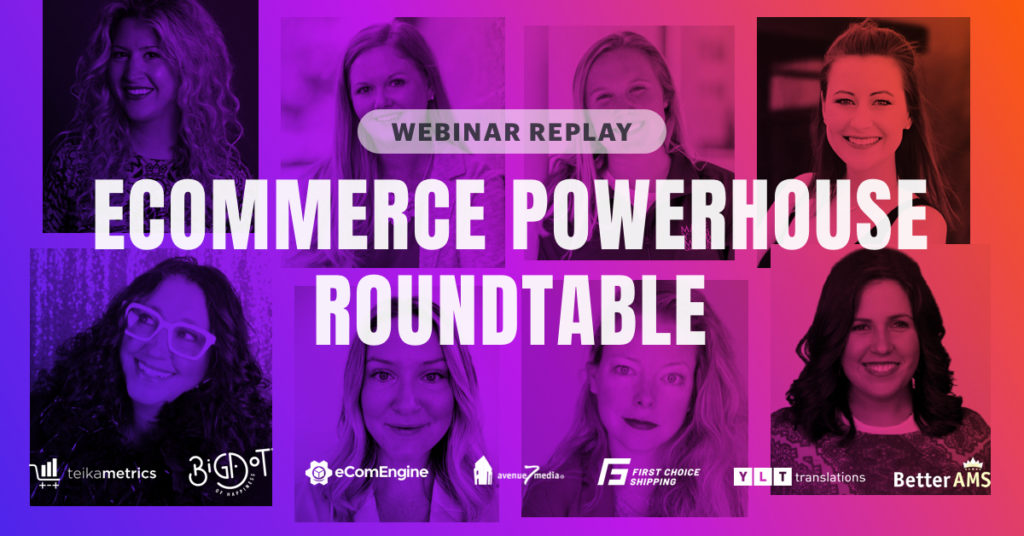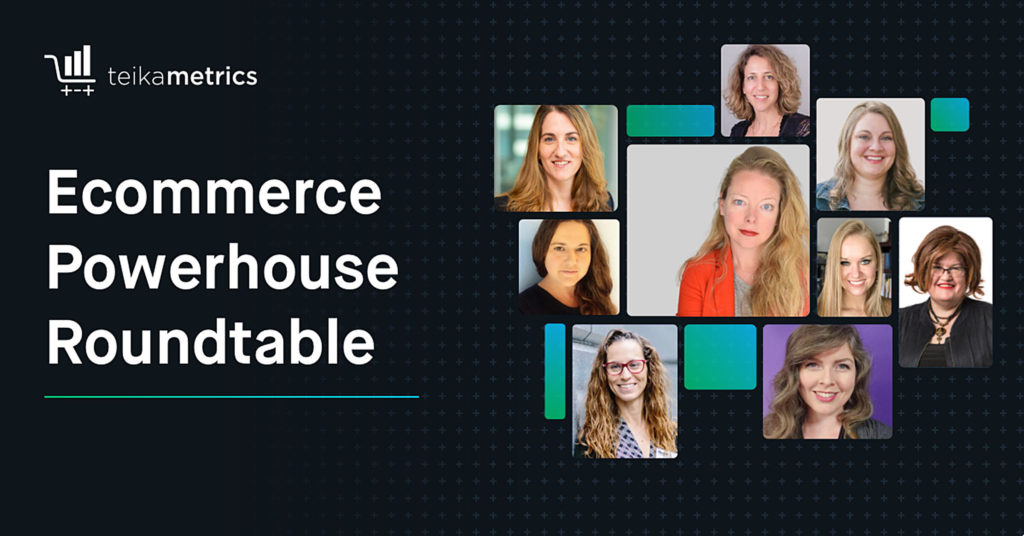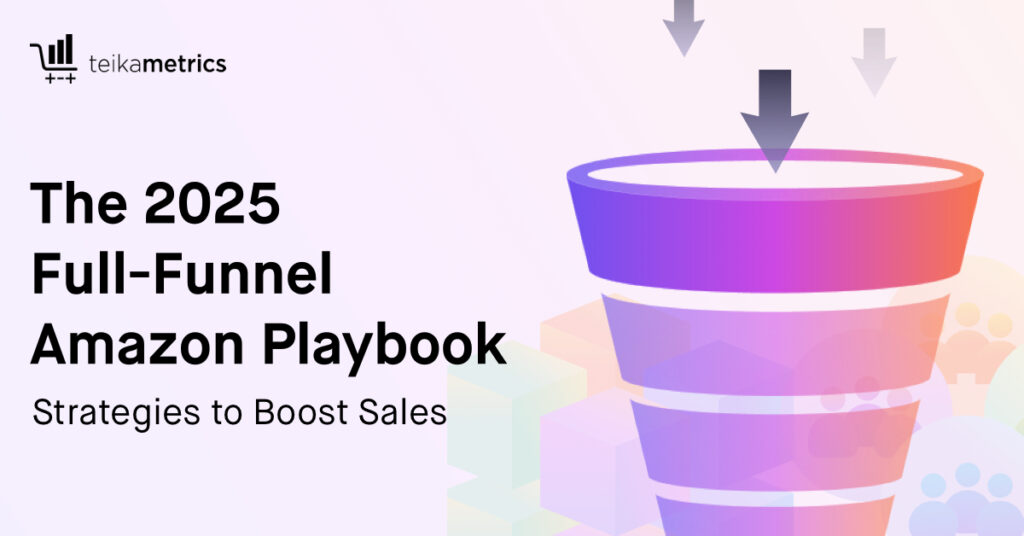Ecommerce has become a necessity for most businesses since the pandemic began. Yet there is no doubt it can be a challenge to keep up with changing trends and customer demands. If you want to take your ecommerce brand to the next level, you need to get ahead of the learning curve. During our latest Teikametrics Roundtable, we interviewed a panel of entrepreneurs and marketing experts on the perks and challenges of selling with Amazon, how to use social media to market your product, and what it means to diversify your portfolio.
Webinar Takeaways
- Expand when you can
- Invest in quick shipping
- Let feedback change your course
- Make it easy to give reviews
- Market with micro-influencers
- Use TikTok over Instagram
- Build up followers through attribution
- Look for external traffic sources
- Be an innovator
- Diversify your brand
Show Links
- Check out YLT Translations and connect with Jana Krekic
- Check out eComEngine and connect with Colleen Quattlebaum
- Check out BetterAMS and connect with Destaney Wishon
- Check out BigDotofHappiness and connect with Sherri Yukel
- Check out Avenue7Media and connect with Teresa Coats
- Check out First Choice Shipping and connect with Pearl Ausch
- Connect with Liz Downing
- Connect with Madeline Dutton
- Check out Teikametrics
- Connect with Teikametrics on Twitter or LinkedIn
Watch The Full Replay
Key Teika-ways
19:20 – Expand when you can
Pearl said it’s important to expand to as many different markets as you can so that if one market goes down, you can move your product to the other markets.
“Expand to as many markets as you can so when one does go down, there’s something else that you could piggyback on. And then if there’s an inventory limit, you have another place that you could send it to. But what I’ve seen from all the marketplaces, I would definitely say Canada has been something that really, really stuck out the most for us. With Brexit happening people were very wary about trying to see what’s going to be the future of their global selling. So a lot of people exerted energy to other places, except for the ones that really pushed through. And those are the ones that are doing very well in the UK. But our data has told us that some people have let go of that market, and we’ve seen a big shift in the Canadian market. So they have been shut down, I would say, more than other countries. And what ended up happening is ecommerce blew up. So we’ve seen sellers that have been doing traditionally about 10% of their sales of what they were doing in the US, in Canada are doing very close to 30% now. And it’s been steadily staying that way, even though things have been opening back up and operations have gone back to normal, a lot of people have changed their buying habits.”
23:09 – Invest in quick shipping
Sherri said Prime shipping is vital for brands because people want their orders to be fulfilled as quickly as possible.
“Ecommerce has been weird in the last, I would say, Q4 logistic constraints. Fulfillment constraints is a real thing, and prime is prime, and it just has to get back to prime because when people still wait till the last minute to shop. We saw a little bit of earlier shopping last year, just because people were afraid of running out product. And you’re still seeing a bit of that, but you still have the last-minute shoppers and they just really need the product. And in our particular game, if it doesn’t arrive in time, they’re gonna send it back. So we believe in prime, and it is getting much better. The fulfillment arenas are opening up left and right. And we’re loving that, our capacity to send more product to Amazon is outstanding.”
24:26 – Let feedback change your course
Destaney said Amazon has matured a lot as a platform because it started listening to its customers’ feedback to find out what they truly wanted.
“The biggest things that we’ve really seen over the last year is just a maturity of the platform. Not only from external pressure, from a lot of the largest brands moving their ad spend dollars from retail onto Amazon, but just a maturity in what the customer wants. They started getting bad reviews, bad feedback from a lot of these knocked-off private label products, and Amazon made a bunch of changes to the review process. They made a lot of changes to KPIs and what influences a really strong performing product, and that maturity, although it may be hard to navigate from the brand side, I think, needed to happen from the customer side. So that was a really big change, along with just the need for flexibility in ecommerce. You had COVID, you had supply chain changes, now you have year over year forecasting. All of these things that are just exponentially more complex than ever before is really forcing a flexibility and a need to understand how the market’s going to perform more than ever before.”
26:40 – Make it easy to give reviews
Colleen said the best way to get an increase in ratings is to make it extremely easy for customers to submit their reviews.
“It’s always a struggle to try to get reviews and feedback. It’s a very low percentage that actually respond to those review requests, but now that Amazon has the request a review button and our tool feedback five and others, you can automate that, that helps sellers make sure that they’re a hundred percent compliant so they don’t have that risk for suspension. And it’s a very mobile, friendly message. All the messages are in the buyer’s language of choice, which is another requirement now. But it just makes it so easy for the consumer to respond. So the ratings in terms of a response rate have come up, but as far as then, obviously that’s a negative for a lot of sellers, because they’re not getting the feedback that they want to hear. So if you get a two or three-star rating, you don’t know why. So that’s a big pain point is not actually seeing the actual comments, that they’re just clicking the star and moving on. So there’s still so much to learn, it’s so valuable to get the actual comments behind the reviews.”
34:35 – Market with micro-influencers
Jana said micro-influencers are a great, cost-effective way to market to new audiences because people are more likely to believe a personal review than an impersonal ad.
“Anybody that has 10K followers are bigger, because as we know advertising has become more and more expensive, like on Amazon. But these influencers and any other UGC, any sort of content that’s organic, it comes from the third side, from the users, or somebody’s telling their own experience. It’s going to be more genuine, and people are going to believe that more than regular advertising. And also these influencers are cheaper than any other form of advertising, and you don’t even have to pay a lot of money to 50K influencers, or maybe even bigger. Talking about TikTok, people can get followers so quickly, much quicker than they can do on Instagram. So I think that people are turning also to UGC a lot, because I can tell you what I want about our service, but if you hear it from my client, that’s going to be really good advertising for me. So that’s basically what UGC is. And I think that’s really something interesting is the rise of the micro-influencers.”
37:57 – Use TikTok over Instagram
Jana said TikTok is the place for brands to advertise. It’s more effective than Instagram because TikTok keeps viewers’ attention better than other social media platforms.
“I’ve seen a lot of bigger brands and tons of other people that I like to follow on TikTok, they have business-related content for product. L’Oreal had a campaign which said TikTok made me buy this. And they did that with all of their products, which ended up with a really, really great engagement. So I really think that now it’s really easy to get a lot of followers, much easier than on Instagram. Right now, I would say go on TikTok over Instagram, because I just think that TikTok is Much more engaging, and you have the videos and the music, and then you have a full-on focus. I read something that says, statistics say that 70% of the users on TikTok they’re focused on the videos and they don’t look at anything else, versus me when I watch a movie I’m on Instagram. It doesn’t have my undivided did attention, but TikTok does.”
43:43 – Build up followers through attribution
Teresa said attribution links can help you build up a following and unlock special programs through Amazon that require a certain number of followers.
“Essentially each one of your attribution links needs to be created pointed to or from the specific platform that you’re sending from. So you need to have an email attribution link set up. You need to have it sent directly from Facebook, from Google, from wherever you’re directing that traffic from. It needs to be a link that’s set up correctly for that. Once that is done, you can send them directly to your ASIN, or you can send it to, honestly, your brand store is what I’m doing right now. That goes hand in hand with building up your followers on Amazon. With that social push that Amazon’s having right now, by gaining those followers, you’re getting programs unlocked, like the ‘manage your customer engagement,’ which you only get access to after so many followers. So with that, Amazon decided to come out with brand referral bonus, which is essentially you’re getting a bonus back that’s coming out of your referral fee. And right now we’re seeing about anywhere from 10 to 12% return on that, that is attributed back to those attribution links.”
46:08 – Look for external traffic sources
Destaney said that because top-of-search advertising is getting more expensive, brands should look for external traffic sources to invest in instead.
“Top of search is incredibly saturated with ad placements. If you’re not in the top four, you have to go through a lot of different placements to even get visibility on your product. So you can do two things. You can continue to pay for what the top of traffic looks like, and it is more pay to play, because we’re limited to the amount of search placements we have to bid on. Or you can start looking at external traffic sources, and that’s the conversation we’ve started having to have with a lot of our brands is, if you’re not willing to pay the $10 to even $40 clicks for top of search, we should push traffic from external sources. Now I will say purchase intent on Amazon is still insanely high. It’s probably one of the highest purchase intent in all of search and display that we see, unless it’s a very hot remarketing campaign. But when you’re paying so much, if you have a lower price point product, you definitely need to start diversifying, because CPCs probably aren’t gonna go down too much. We have a limited amount of placements that we can all bid on. So the more people that are bidding, the more money that enters the space, the more expenses that it’s gonna be.”
54:55 – Be an innovator
Pearl said the people who are willing to head into the unknown are the ones who will succeed in the market, because they got there first.
“The people that are willing to walk through the mud, and get their feet wet, and try to do what nobody else is doing are the ones that are constantly going to see the most success. Yana, you mentioned the UAE market, we kept saying, the first ones to market are going to be the ones that are going to be there for the long run. And we do see that. We do see the very first shippers, they actually launched the market together with Amazon. So we worked together with them to create a model of shipping from the US into FDA, UAE. And we’ve seen the same people that started then are constantly increasing the amounts they’re shipping. So people are doing much better when they start out and they’re the pioneers, and I say the same for Europe now.”
1:08:05 – Diversify your brand
Sherri said diversification is critical for every brand. Don’t just limit yourself to Amazon—if you want to grow your brand, you have to cast a wider net.
“Diversification is absolutely critical. You can’t be all just an Amazon brand. You have to be very diversified, and going Amazon international to investors is still Amazon. So they do want you to diversify. Clearly we sell on other channels such as Walmart. Target was a big ad recently, and we have four more launching very, very soon. So I will just say that I’m more than happy. I’m still the CEO. I still own a significant portion of our brand. And I think it’s really good when your company hits a certain point to do such a thing. In general, I know aggregates, I think there’s some good ones out there. I think there’s some bad ones out there. You’ve just got to be careful where you’re going.”






